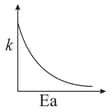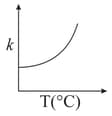MEDIUM
JEE Main
IMPORTANT
Earn 100
In the following reaction;
‘A’ and ‘B’ respectively can be:
(a) and
(b) and
(c)n-Butane and Iso-butane
(d) and
56.52% studentsanswered this correctly

Important Questions on Chemical Kinetics
HARD
JEE Main
IMPORTANT
For an elementary chemical reaction, , the expression for is:
HARD
JEE Main
IMPORTANT
Consider the given plots for a reaction obeying Arrhenius equation (and are rate constant and activation energy, respectively )
(I)

(II)

MEDIUM
JEE Main
IMPORTANT
For the reaction of with , the rate constant is at and at . The activation energy for the reaction, in is:
MEDIUM
JEE Main
IMPORTANT
A bacterial infection in an internal wound grows as , where the time is in hours. A dose of antibiotic, taken orally, needs 1 hour to reach the wound. Once it reaches there, the bacterial population goes down as . What will be the plot of vs after hour?
MEDIUM
JEE Main
IMPORTANT
For a first order reaction, the time required for completion of reaction is '' times the half life of the reaction. The value of '' is
(Given: and )
HARD
JEE Main
IMPORTANT
For a given chemical reaction . Concentration of changes from to in Rate of appearance of is times the rate of disappearance of which is twice the rate of disappearance . The rate of appearance of has been experimentally determined to be Therefore the rate of reaction is____ (Nearest Integer)
MEDIUM
JEE Main
IMPORTANT
Catalyst A reduces the activation energy for a reaction by at . The ratio of rate constants, is . The value of is____[nearest integer] [Assume that the pre-exponential factor is same in both the cases. Given ]
MEDIUM
JEE Main
IMPORTANT
A flask is filled with equal moles of and . The half lives of and are and respectively and are independent of the initial concentration. The time required for the concentration of to be four times that of is____.
(Given : )
